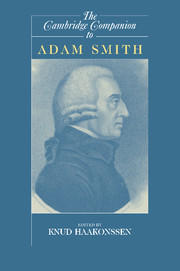Book contents
- Frontmatter
- Introduction: The Coherence of Smith’s Thought
- 1 Imagination: Morals, Science, and Arts
- 2 Adam Smith, Belletrist
- 3 Adam Smith’s Theory of Language
- 4 Smith and Science
- 5 Smith on Ingenuity, Pleasure, and the Imitative Arts
- 6 Sympathy and the Impartial Spectator
- 7 Virtues, Utility, and Rules
- 8 Adam Smith on Justice, Rights, and Law
- 9 Self-Interest and Other Interests
- 10 Adam Smith and History
- 11 Adam Smith’s Politics
- 12 Adam Smith’s Economics
- 13 The Legacy of Adam Smith
- Bibliography
- Index
Introduction: The Coherence of Smith’s Thought
Published online by Cambridge University Press: 28 August 2006
- Frontmatter
- Introduction: The Coherence of Smith’s Thought
- 1 Imagination: Morals, Science, and Arts
- 2 Adam Smith, Belletrist
- 3 Adam Smith’s Theory of Language
- 4 Smith and Science
- 5 Smith on Ingenuity, Pleasure, and the Imitative Arts
- 6 Sympathy and the Impartial Spectator
- 7 Virtues, Utility, and Rules
- 8 Adam Smith on Justice, Rights, and Law
- 9 Self-Interest and Other Interests
- 10 Adam Smith and History
- 11 Adam Smith’s Politics
- 12 Adam Smith’s Economics
- 13 The Legacy of Adam Smith
- Bibliography
- Index
Summary
SMITH’S LIFE
While Adam Smith is a household name as an economist, his political economy was only part of a comprehensive philosophical system centering on the nature of human action in general. The subsequent essays analyze the main parts of Smith's system; in this introduction, I attempt a synoptic view of the coherence of that system. As we will see, Smith's systematic achievement can be understood as a bold undermining of an ancient dispute between Stoics and Epicureans, which had been revived in early modern philosophy. Th is is not surprising when we look at the matter from the point of view of Smith's life. After schooling in his native Kirkcaldy, Smith went to the University of Glasgow (1737–40), where the main influence on him was Francis Hutcheson, who was one of the main representatives in the English-speaking world of Christianized Stoicism. However, in his twenties when he was a freelance public lecturer in Edinburgh (1748–50), Smith formed the most important friendship of his life with David Hume, the most sophisticated heir to a mixed Epicurean and sceptical tradition. What is more, while he was a student at Balliol College, Oxford, from 1740 to 1746, Smith seems to have immersed himself in this intellectual confrontation by extensive studies in recent French literature and criticism, where such disputes were prominent. In view of such a mixed background, which presumably has found expression in his Edinburgh lectures, it is hardly surprising that Hutcheson’s former students received Smith less than enthusiastically when the latter took up his former teacher’s professorship at Glasgow. Smith taught at Glasgow from 1751 to 1764, and was succeeded by the Common Sense philosopher Thomas Reid who was an important critic of both Smith and Hume. The most distinguished student of Smith’s, from an intellectual point of view, was John Millar who, as professor of law in the same university, developed Smith’s analysis of social authority and law.
- Type
- Chapter
- Information
- The Cambridge Companion to Adam Smith , pp. 1 - 21Publisher: Cambridge University PressPrint publication year: 2006
- 15
- Cited by



